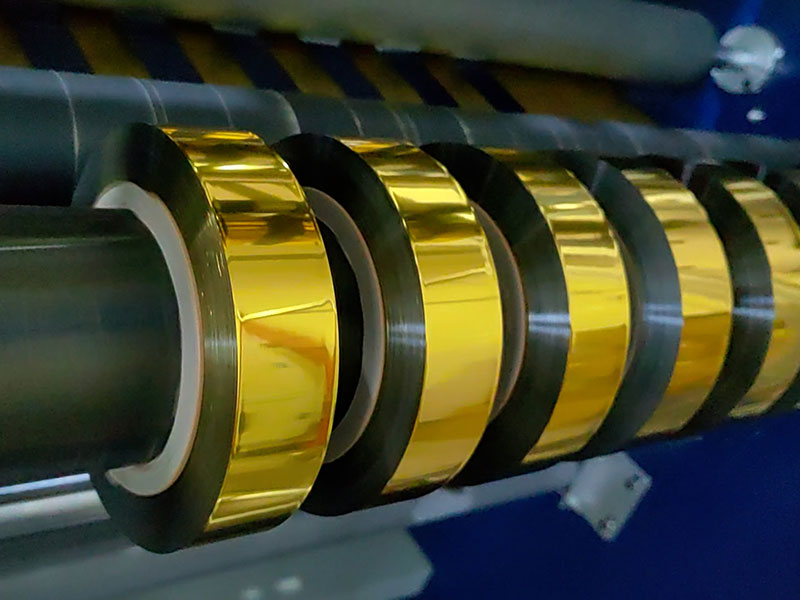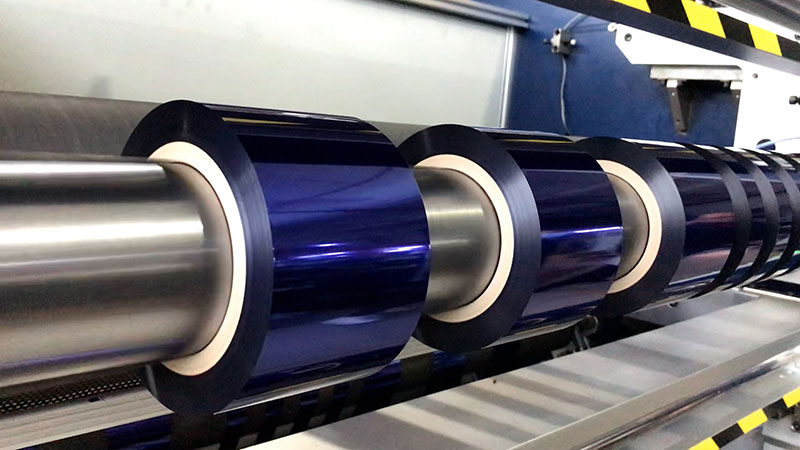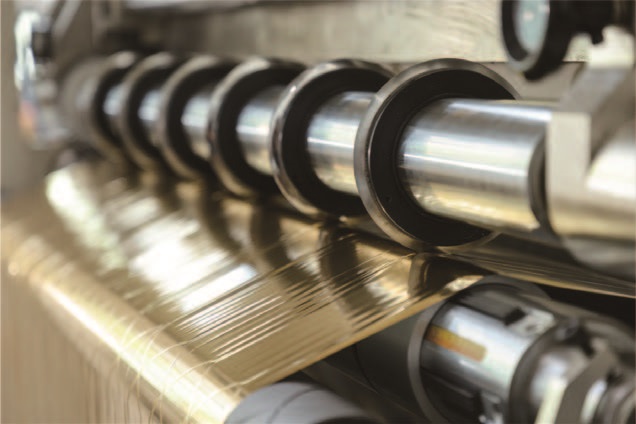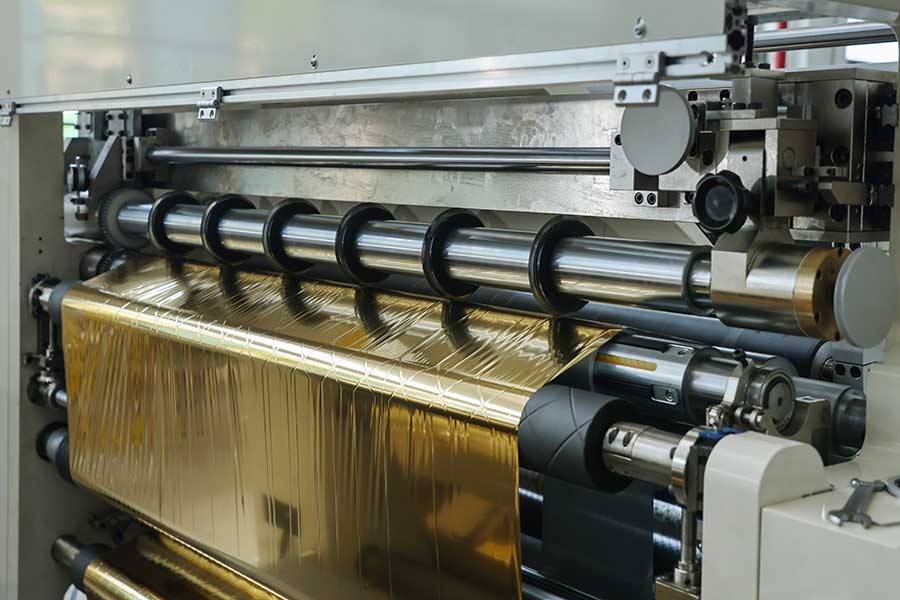The core principle of choosing a slitting machine is that the slitting machine must handle the hot stamping foil of a particular material "gently" and "precisely" enough to avoid any damage to it during the slitting process. Any scratches, indentations, stretches or static electricity will cause the hot stamping foil to be scrapped.
Here is a detailed selection guide based on different foil materials:

First, understand the basic structure of hot stamping foil
Foil stamping usually consists of 5 layers:
1. Base film (PET film): The bearing layer, usually polyester film (PET), is usually between 12-19μm thick.
2. Detachment layer: melts after heating, separating the pigment layer from the base film.
3. Pigment layer (aluminized layer): Provides color and metallic effects.
4. Adhesive layer: Activated after heating, the pattern is pasted on the ironing object.
5. Adhesive Layer: Sometimes present to protect the adhesive layer.
The main objects that are touched and protected during the slitting process are the most sensitive pigment layer and the most fragile base film.

Second, the correspondence between key material characteristics and the configuration of the slitting machine
| Hot stamping foil material/type | Key Features and Challenges | Recommended slitting machine key configurations | Explain why |
| Plain paper foil | The material is relatively hard, has good resistance, and requires medium precision. | - Standard precision slitting machine - Circular knife slitting - Normal steel or carbon steel tension system - Basic static eliminator | The most common type, which does not require high equipment requirements, cost-effectiveness is the primary consideration. |
| Plastic foil (ABS, PVC, PE, etc.) | The adhesive layer is thick or sticky, prone to stretching and adhesion (mucous membrane). | - High-precision tension control system (magnetic powder or servo motor) - Mirror roller or silicone roller - Cooling system (optional) - Anti-stick blade (Teflon coated blade) | Precise microtension avoids stretch deformation. The smooth mirror roller and anti-stick blade effectively prevent mucous membranes and protect the coating. |
| Fabric foil (textile hot stamping) | Very soft, the base film may be thinner, very prone to wrinkles and strains. | - Ultra-low tension control system (servo motor optimal) - Large flattening rollers - Airbag or spiral retraction reels - Full contact rewinding (surface rewinding) | Gentle tension and leveling mechanism are key to preventing wrinkling and deformation. The airbag shaft can evenly pressure and avoid bulging in the middle during winding. |
| Laser laser foil | The surface has a fine microstructure (diffraction pattern), which is very easy to scratch and extremely sensitive to scratches and indentations. | - Non-contact (air knife) slitting - Mirror roller (ultra-high finish) - Full servo drive (extremely precise tension control) - Clean shop environment | Scratches are fatal. Air knife slitting completely avoids the contact of the blade with the foil surface. All rollers in contact must be mirror and dust-free. |
| Metallic foil (coarse-grained) | The pigment layer is thick, the grain is strong, and it is easy to produce dust peeling. | - Slitting machine with vacuum suction - Wear-resistant blades - Robust body construction | Dust generated during slitting can contaminate equipment and the working environment, making a vacuum cleaner essential. Thicker coatings wear more on the blades. |
| Transparent foil | There is no metal layer, scratches and fingerprints are easily visible, and the cleanliness requirements are extremely high. | - Mirror rollers - Dust-free environment - Operator needs to wear gloves - High precision slitting | Any minor damage will be very noticeable against a transparent background, and protecting the surface finish is a priority. |

Third, the core components that must be examined when choosing a slitting machine
Regardless of the type of hot stamping foil, the following components are at the heart of determining whether a slitting machine is suitable or not:
1. Slitting method
◦ Contact cutting: the most common and efficient. Suitable for most conventional foils. The key is whether the tool holder is designed to be easy to adjust and maintain stability.
◦ Air Cutting: High-end configuration for extremely sensitive materials such as laser laser foils. Non-contact slitting is achieved through high-pressure airflow, completely eliminating scratches. Expensive.
◦ Shear Cutting: The upper and lower cutterheads bite like scissors, with high slitting accuracy and long blade life, suitable for slitting wider and thicker materials.
2. Tension control system - this is the "soul" of the slitting machine
◦ Magnetic powder clutch/brake: traditional solution, simple control, low cost, but average accuracy and response speed, easy to heat up after long-term work.
◦ Full servo motor control system: standard on modern high-end slitting machines. The tension control is extremely precise and stable, adjustable from a minimum tension close to 0, making it ideal for ultra-thin, soft fabric foils and sensitive foils. It is the guarantee to achieve high-quality slitting.
3. Roller system
◦ Flattening roller: Eliminates internal stress of the material before slitting and prevents wrinkling. Fabric foil is a must.
◦ Mirror rollers: The surface of the roller in contact with the material is highly polished and mirror-smooth, and is used to protect the surface of sensitive foils.
◦ Press roller: The rubber pressure roller used for winding can discharge the air in the roll, making the winding tighter and flatter.
4. Rewinding and unwinding mechanism
◦ Slip axis: Generate friction through air pressure or mechanical means to achieve center winding, which is the mainstream at present.
◦ Airbag shaft: It can perfectly fit the coil core after expansion, especially suitable for finished rolls that need to be shipped directly after slitting, to ensure that the end face is neat.
◦ Surface winding: The coil is driven by direct friction with a drive roller, and the tension is very soft, making it suitable for materials that are very easy to stretch.
5. Static eliminator
◦ Slitting high-speed friction will inevitably generate static electricity, which will absorb dust, lead to uneven winding and even cause fire. Ionic wind electrostatic rods are a must-have, especially for plastic foils and dry environments.
6. Vacuum system
◦ For dust-generating materials (such as some metal foils), the built-in vacuum port keeps the cutter area clean, guarantees slitting quality, and protects the equipment.
Summary and suggestions
1. Identify the main products: Start by determining which type of foil you primarily process. If the business is diverse, the equipment should be selected according to the highest standards, such as taking into account both laser and fabric foils.
2. Budget and Allocation Tradeoffs:
◦ Economical: If you only cut ordinary paper foil, you can choose a standard slitting machine equipped with magnetic powder tension and circular knife slitting.
◦ Professional type: If it involves plastic foil or coarse-grained foil, it is necessary to choose a model with more precise tension control (servo or high-end magnetic powder), with vacuum suction and mirror rollers.
◦ High-end type: If processing laser laser foil, transparent foil, and high-grade fabric foil, full servo drive, air knife slitting (or ultra-high-precision circular cutter), mirror roller, and large flattening roller are almost essential.
3. Testing is key: Before purchasing, be sure to provide your hot stamping foil samples to the equipment supplier for on-site testing. Carefully check whether the end face of the coil after slitting is neat, whether there are scratches, and whether the tension is uniform (whether there is stretching or wrinkling).
4. Brand and after-sales: Choose a brand with a good reputation and fast technical service response. Slitting machines are precision equipment, and regular maintenance and commissioning are important.
Hopefully, this detailed guide will help you make the most suitable choice!

Every millimeter of precise slitting, every technological breakthrough, silently speaks of the brand's persistent pursuit of perfection.
31. December, 2025
The traditional large-scale standardized production model is gradually transforming into a customized direction with small batches, multiple specifications, and fast delivery.
31. December, 2025
This article will provide an in-depth explanation of the five core technical parameters of hot foil slitting equipment to help you make informed purchasing decisions.
31. December, 2025
With the emergence of high-precision hot stamping foil slitting machines, this industry pain point is being fundamentally solved.
30. December, 2025
The emergence of automated slitting technology is providing innovative solutions to this industry problem.
30. December, 2025